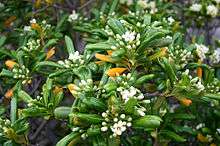Pittosporum tobira
| Pittosporum tobira | |
|---|---|
 | |
| Leaves and flowers of P. tobira | |
| Scientific classification | |
| Kingdom: | Plantae |
| (unranked): | Angiosperms |
| (unranked): | Eudicots |
| (unranked): | Asterids |
| Order: | Apiales |
| Family: | Pittosporaceae |
| Genus: | Pittosporum |
| Species: | P. tobira |
| Binomial name | |
| Pittosporum tobira (Thunb.) W.T.Aiton | |
Pittosporum tobira is a species of flowering plant in the Pittosporum family known by several common names, including Australian laurel,[1] Japanese pittosporum,[1] mock orange[1] and Japanese cheesewood. It is native to Japan, China, and Korea,[2] but it is used throughout the world as an ornamental plant in landscaping and as cut foliage.

It is an evergreen shrub which can reach 10 m (33 ft) tall by 3 m (10 ft) broad,[2] and can become treelike. It can also be trimmed into a hedge. The leaves are oval in shape with edges that curl under and measure up to 10 cm (4 in) in length. They are leathery, hairless, and darker and shinier on the upper surfaces. The inflorescence is a cluster of fragrant flowers occurring at the ends of branches. The flower has five white petals each about a centimetre long. The fruit is a hairy, woody capsule about 1 cm wide divided into three valves. Inside are black seeds in a bed of resinous pulp.
The binomial qualifier tobira derives from the Japanese name for the plant.[3]
This shrub is a common, drought-tolerant and fairly hardy landscaping plant. Many cultivars have been developed, including dwarf forms and the popular 'Variegata', which has variegated leaves.[4] It is used for hedges, living privacy screens, and indoor and outdoor planter boxes.[4] The stems, leaves, and dried fruits are used in flower arrangements.[4]
The species[5] and the cultivar 'Variegatum'[6] have both gained the Royal Horticultural Society's Award of Garden Merit.
Common pests of this plant include various aphids, mites, and leafhoppers, the cotton cushiony scale (Icerya purchasi), and root-knot nematodes (Meloidogyne spp.).[4] It can be attacked by the pit-making pittosporum scale (Planchonia arabidis).[7] It is vulnerable to the fungal plant pathogen Erythricium salmonicolor, which causes galls and the dieback disease known as pink limb blight.[4]
References
- 1 2 3 USDA GRIN Taxonomy, retrieved 3 May 2016
- 1 2 RHS A-Z encyclopedia of garden plants. United Kingdom: Dorling Kindersley. 2008. p. 1136. ISBN 1405332964.
- ↑ Harrison, Lorraine (2012). RHS Latin for gardeners. United Kingdom: Mitchell Beazley. p. 224. ISBN 9781845337315.
- 1 2 3 4 5 Stamps, R. H. Tobira Production and Use
- ↑ "RHS Plant Selector - Pittosporum tobira". Retrieved 27 May 2013.
- ↑ "RHS Plant Selector - Pittosporum tobira 'Variegatum'". Retrieved 27 May 2013.
- ↑ UC Davis IPM
External links
| Wikispecies has information related to: Pittosporum tobira |
| Wikimedia Commons has media related to Pittosporum tobira. |